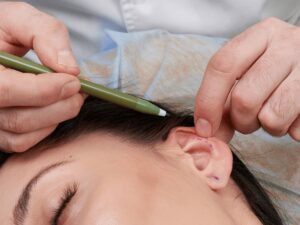Ever been wondering what could make hyperbaric oxygen therapy risky for some people? Hyperbaric oxygen therapy, a popular treatment for various health conditions, has contraindications that could pose potential complications, creating a need for business owners to be aware and informed.
This guide will delve into the comprehensive understanding of the contraindications associated with hyperbaric oxygen therapy. From detailing individual health conditions to the possible complications of the therapy, this guide provides a holistic view to navigate this intricate field effectively. As an expert in the field, I understand how vital this knowledge is for business owners.
Still seeking to enhance understanding and mitigate potential risks in the health business? Read on!
1. Understanding Contraindications in Hyperbaric Oxygen Therapy
Hyperbaric oxygen therapy (HBOT) can bring significant health benefits, but it’s not suitable for everyone. There’s a pressing need to understand the contraindications, which are conditions or factors that serve as a reason to withhold a certain medical treatment due to the harm it may cause the patient. Let’s first have a throwback with the therapy itself:
Definition
Contraindications for HBOT are specific situations or conditions where this therapy may cause harm, outweighing its potential benefits. In the context of HBOT, contraindications fall into two main categories: absolute and relative. In this sense, being aware of contraindications safeguards the well-being of patients receiving therapy.
Importance
Knowing the contraindications is a fundamental aspect of HBOT practice. Ignorance can lead to unnecessary complications or ineffective treatment. Thus, accurate knowledge of contraindications helps to ensure that patients reap the most benefits while minimizing the risks involved. I have learned that understanding and respecting these contraindications forms the bedrock of successful therapy outcomes.
Screening Process
A thorough screening process is a vital part of patient evaluation before hyperbaric oxygen therapy. This step ensures that HBOT is suitable for the patient and that potential risks are identified and addressed accordingly. Here’s a closer look at some key components of the screening process:
- Medical History Review: This review can reveal underlying health conditions or previous treatments that could affect the safety or effectiveness of HBOT. Details about past and current illnesses, surgeries, medications, allergies, and lifestyle factors are all part of this crucial stage.
- Physical Examination: This examination can uncover signs of disease or conditions that may not have been disclosed or discovered during the medical history review. This includes a general health assessment, as well as specific tests such as an ear exam, to ensure the patient can withstand changes in pressure.
- Diagnostic Tests: Depending on the initial findings from the medical history review and physical examination, these tests can include blood tests, imaging studies, or specialized assessments. For example, lung function tests might be necessary for patients with respiratory conditions.
- Risk-Benefit Analysis: This involves weighing the potential advantages of HBOT for the patient against the possible risks and complications. This step requires careful judgment and should take into account all the information gathered during the screening process.
- Informed Consent: This ensures that the patient is aware of the potential risks, understands the procedure, and agrees to undergo the treatment.
2. Absolute Contraindications
Absolute contraindications in hyperbaric oxygen therapy refer to circumstances in which HBOT is strictly not recommended, regardless of the potential benefits. These circumstances are based on evidence indicating high risks of adverse events or complications from HBOT. The following are some of the key absolute contraindications:
Uncontrolled Airway Obstruction
A severe risk during HBOT is presented by uncontrolled airway obstruction. This condition can prevent the necessary equalization of pressure during treatment, which could lead to potential lung damage. In some severe cases, it could even trigger life-threatening complications. Hence, airway obstruction is a significant concern that warrants an absolute contraindication.
Pneumothorax or Thoracic Air Trapping
According to a study found in National Library of Medicine, pneumothorax is a collection of air outside the lung but within the pleural cavity which air accumulation can apply pressure, that can lead to a collapsed lung. Given that HBOT involves changes in pressure, these conditions can worsen and result in a life-threatening situation. Hence, HBOT is not recommended for these patients.
Severe Chronic Obstructive Pulmonary Disease (COPD)
For patients with severe COPD, HBOT can potentially lead to respiratory failure. This is due to the increased oxygen levels during therapy, which can exacerbate COPD. Therefore, severe COPD is considered an absolute contraindication for HBOT. In my practice, maintaining patient safety is always the top priority, and this sometimes means exploring other treatment options.
Untreated Malignancies
The relationship between untreated malignancies and HBOT is complex. Some studies suggest potential benefits of HBOT for certain types of cancers. However, concerns that increased oxygen may stimulate the growth of cancer cells make untreated malignancies an absolute contraindication.
Active Viral Infections
Active viral infections pose a potential risk during HBOT. There are concerns that in an oxygen-rich environment, viruses may replicate more rapidly, leading to worsened conditions. Therefore, active viral infections are considered an absolute contraindication. I have learned that staying informed about a patient’s current health status is critical to avoid such risks.
Uncontrolled Seizure Disorders
Patients with uncontrolled seizure disorders may face a lower seizure threshold due to increased oxygen during HBOT, potentially triggering seizures. The risk of inducing seizures is a serious concern, hence such conditions are deemed as absolute contraindications for HBOT.
Claustrophobia
While not a physiological contraindication, claustrophobia can lead to significant discomfort or anxiety during HBOT, which is typically delivered in an enclosed chamber. If the patient’s distress due to claustrophobia impedes the therapy, this is considered an absolute contraindication. To address such concerns, OxygenArk designs chambers that aim to create a more comfortable and less restrictive environment for the patients.
3. Relative Contraindications
Relative contraindications are conditions that may require extra caution or adjusted treatment protocols in HBOT. These conditions do not automatically rule out HBOT, but the risks and benefits must be carefully considered. Below are a few relative contraindications:
Chronic Sinusitis
Patients with chronic sinusitis may find it challenging to equalize pressure in their sinuses during HBOT, leading to discomfort and potentially more serious complications. Although this is not an absolute contraindication, it is considered a relative one and requires careful evaluation.

History of Ear Surgery
A history of ear surgeries can impede the ability to equalize pressure in the ears during HBOT. This can lead to ear discomfort or, in rare cases, barotrauma. Thus, such a medical history is seen as a relative contraindication.

Congestive Heart Failure (CHF)
According to WebMD, having heart failure means that heart muscle might be weaker and may not pump blood the way it normally would, it will be suggested to start oxygen therapy. HBOT might increase the workload of the heart, a concern for patients with CHF. Therefore, the risk-benefit ratio must be evaluated carefully before considering this therapy, making CHF a relative contraindication.

Diabetes Mellitus
While HBOT can aid wound healing in diabetic patients, it might also affect blood sugar levels. This necessitates close monitoring during therapy, making diabetes a relative contraindication. From my perspective, close collaboration with a patient’s primary care physician is paramount to navigate these complexities.

Age Considerations
Ageing is a journey of profound change and adaptation. In the context of HBOT, the ageing process can modify the physiological response to the treatment. Older patients often have multiple coexisting medical conditions, making age a relative contraindication.

Fever
A fever increases the body’s metabolic rate and, consequently, its oxygen demand. This increase can be exacerbated by HBOT, making fever a relative contraindication for this therapy. Throughout my career, I’ve seen how essential it is to consider the broader health context of each patient before proceeding with HBOT.

History of Severe Barotrauma
Patients with a history of severe barotrauma may face an elevated risk of similar incidents during HBOT. This history is considered a relative contraindication, necessitating careful evaluation before treatment. As a manufacturer of hyperbaric chambers, OxygenArk ensures the inclusion of safety features in their chambers to mitigate such risks.

4. Contraindications for Specific Patient Groups
In the intricate world of hyperbaric oxygen therapy, acknowledging contraindications specific to distinct patient groups is indispensable. The variance in physiological responses to therapy can present certain risks for different demographics. Safety, being the foremost concern, brings the necessity to understand contraindications for specific patient groups. Let’s explore more in these specific groups:
Pediatric Patients
Children have a unique set of physiological characteristics, which require careful consideration when administering hyperbaric oxygen therapy. Their developing bodies react differently to high oxygen levels. It’s crucial to have specialized medical professionals assess pediatric patients thoroughly. The overall health, medical history, and unique needs of the child should be taken into account before moving forward.
Geriatric Patients
As individuals age, their body’s response to medical treatments can drastically change. Geriatric patients often have multiple coexisting conditions, which can complicate their HBOT treatment. Therefore, it’s necessary to evaluate these patients carefully before initiating therapy. Additionally, age-related physiological changes can affect the response to HBOT, necessitating adjustments in the therapy protocol.
Pregnant Women
Pregnancy presents a unique physiological state, which poses challenges for hyperbaric oxygen therapy. Oxygen toxicity can impact both the mother and the fetus. Therefore, absolute caution and a thorough assessment of risks versus benefits is essential. It is commonly recommended to avoid this therapy during pregnancy unless urgently necessary.
Elderly Individuals
While the term ‘elderly’ might seem similar to ‘geriatric’, it’s necessary to address them separately as their physiological reactions can vary significantly. High oxygen levels can be troublesome for elderly individuals who might already have underlying health issues. Again, an extensive health evaluation is necessary for this group before commencing therapy.
Patients With Compromised Immune Systems
Patients with compromised immune systems may face additional risks during HBOT. Any pre-existing conditions need careful management, its essential to balance the potential benefits of therapy against possible risks to these patients. The heightened metabolic demands during treatment could further stress their systems. As such, this patient group requires meticulous evaluation before considering HBOT.
Patients With Diving-Related Injuries
Diving-related injuries, such as decompression sickness, are often treated with hyperbaric oxygen therapy. Divers might have sustained other injuries or have pre-existing conditions that can influence the therapy’s outcome.
The rapid pressure changes experienced by divers may affect the approach to their treatment in a hyperbaric chamber. A comprehensive medical review is crucial before starting treatment for diving-related injuries.
5. Potential Side Effects and Complications
Just like any treatment, hyperbaric oxygen therapy carries potential side effects and complications. Understanding these potential issues is essential for risk mitigation and proper patient management. Here are the potential side effects and complications of hyperbaric oxygen therapy:
Barotrauma
Barotrauma, damage caused by changes in pressure, is a potential side effect of HBOT. For example, the ear and sinus barotrauma are particularly common, given the significant pressure changes during the treatment. To mitigate this, patients are often taught techniques to equalize pressure. However, despite these precautions, barotrauma can still occur in some cases.
Oxygen Toxicity
The delivery of 100% oxygen under pressure during HBOT poses a risk of oxygen toxicity. This can affect the central nervous system and result in symptoms like twitching, seizures, dizziness, and visual or auditory changes. Though rare, it is a serious complication that mandates immediate attention and intervention.
| Risk of Oxygen Toxicity |
Explanation |
| Increased Oxygen Levels |
HBOT involves breathing pure oxygen at higher pressures, leading to elevated oxygen levels in the body. |
| Pulmonary Oxygen Toxicity |
High levels of oxygen can damage lung tissues, causing inflammation and respiratory distress. |
| Central Nervous System (CNS) Toxicity |
Oxygen toxicity can affect the CNS, leading to seizures, visual disturbances, or other neurological effects. |
| Symptoms and Severity |
The risk of toxicity increases with prolonged exposure and higher oxygen concentrations used during therapy. |
| Individual Susceptibility |
Some individuals may be more susceptible to oxygen toxicity due to pre-existing conditions or genetic factors. |
Vision Changes
Transient vision changes, specifically myopia, are a known side effect of HBOT. After a series of treatments, patients may notice a shift towards nearsightedness. However, this is usually temporary, with vision typically returning to pre-treatment levels a few weeks to months after therapy completion. It’s important to reassure patients about the transient nature of these vision changes to alleviate any undue stress.
Pulmonary Edema
There is a potential risk of pulmonary edema, a condition characterized by fluid accumulation in the lungs. It is a serious complication that warrants immediate medical attention. This might occur due to the increased oxygen load during HBOT, which could strain the heart and circulatory system. Maintaining open communication about potential complications like these can help facilitate quicker responses should they occur.
Decompression Sickness
Decompression sickness, often associated with diving accidents, is a potential complication of HBOT, especially when treatment sessions are long and the pressure changes are rapid. Symptoms may include joint and muscle pain, dizziness, fatigue, and in severe cases, paralysis. Although rare in a controlled medical setting, understanding this potential complication is key to providing safe and effective HBOT.
Conclusion
It’s evident that contraindications play a pivotal role in the administration of Hyperbaric Oxygen Therapy. Every patient is unique, and this uniqueness extends to their health status and how they respond to treatments such as HBOT. Adhering to this philosophy is what has guided my success in the field, and I am confident it will do the same for others.
OxygenArk, a reputable manufacturer of hyperbaric chambers, offers a wide range of solutions designed with the utmost attention to safety and quality. Please, don’t hesitate to contact us for any inquiries related to our product range or if you have any questions about HBOT. Our team is always ready to assist and guide you.







